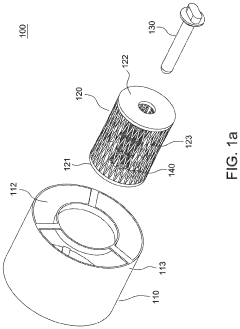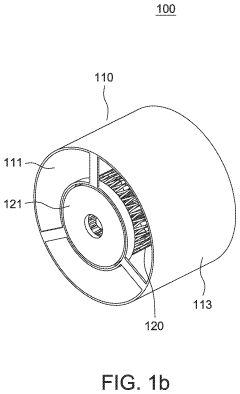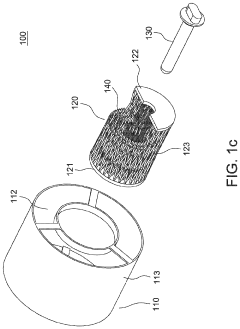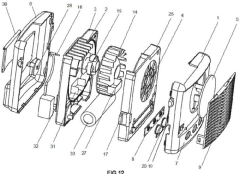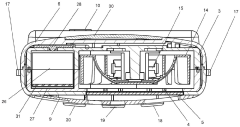Exploring Photocatalytic Disinfection Strategies in Public Transport Systems
OCT 21, 20259 MIN READ
Generate Your Research Report Instantly with AI Agent
Patsnap Eureka helps you evaluate technical feasibility & market potential.
Photocatalytic Disinfection Background and Objectives
Photocatalytic disinfection has emerged as a promising technology for addressing microbial contamination in various environments, particularly in high-traffic public spaces. The concept dates back to the 1970s when Fujishima and Honda discovered the photocatalytic properties of titanium dioxide (TiO2). Since then, the field has evolved significantly, with researchers exploring various semiconductor materials and activation methods to enhance disinfection efficiency.
The evolution of photocatalytic technology has been marked by several key developments. Initially focused on water purification applications, the technology has gradually expanded to air disinfection and surface sterilization. The discovery of visible light-activated photocatalysts in the early 2000s represented a significant breakthrough, overcoming the limitation of UV-dependent systems and enabling applications in ambient lighting conditions.
Recent advancements have focused on improving catalyst efficiency, reducing activation energy requirements, and developing composite materials with enhanced antimicrobial properties. The COVID-19 pandemic has accelerated interest in this field, highlighting the urgent need for effective, sustainable disinfection solutions in public spaces, particularly transportation systems where pathogen transmission risks are elevated.
Public transport systems present unique challenges for disinfection due to high passenger turnover, diverse surface materials, variable environmental conditions, and operational constraints. Traditional chemical disinfection methods often involve harsh chemicals, require frequent reapplication, and may contribute to antimicrobial resistance development. Photocatalytic disinfection offers a potentially sustainable alternative that provides continuous protection without these drawbacks.
The primary objective of this research is to evaluate the feasibility and effectiveness of implementing photocatalytic disinfection strategies in public transportation environments. Specifically, we aim to identify optimal photocatalytic materials and configurations suitable for different transportation contexts (buses, trains, subways, etc.), assess their performance against relevant pathogens under realistic operational conditions, and determine integration approaches that balance disinfection efficacy with practical implementation considerations.
Secondary objectives include quantifying the potential public health benefits through reduction in pathogen load and transmission risk, evaluating the economic implications including installation and maintenance costs versus traditional disinfection methods, and assessing environmental sustainability aspects such as energy consumption and potential byproduct formation.
This research seeks to bridge the gap between laboratory-proven photocatalytic technologies and real-world applications in transportation systems, addressing technical challenges while considering operational, economic, and regulatory factors that influence adoption. The ultimate goal is to develop evidence-based recommendations for transportation authorities and policymakers regarding the implementation of photocatalytic disinfection as part of comprehensive infection prevention strategies.
The evolution of photocatalytic technology has been marked by several key developments. Initially focused on water purification applications, the technology has gradually expanded to air disinfection and surface sterilization. The discovery of visible light-activated photocatalysts in the early 2000s represented a significant breakthrough, overcoming the limitation of UV-dependent systems and enabling applications in ambient lighting conditions.
Recent advancements have focused on improving catalyst efficiency, reducing activation energy requirements, and developing composite materials with enhanced antimicrobial properties. The COVID-19 pandemic has accelerated interest in this field, highlighting the urgent need for effective, sustainable disinfection solutions in public spaces, particularly transportation systems where pathogen transmission risks are elevated.
Public transport systems present unique challenges for disinfection due to high passenger turnover, diverse surface materials, variable environmental conditions, and operational constraints. Traditional chemical disinfection methods often involve harsh chemicals, require frequent reapplication, and may contribute to antimicrobial resistance development. Photocatalytic disinfection offers a potentially sustainable alternative that provides continuous protection without these drawbacks.
The primary objective of this research is to evaluate the feasibility and effectiveness of implementing photocatalytic disinfection strategies in public transportation environments. Specifically, we aim to identify optimal photocatalytic materials and configurations suitable for different transportation contexts (buses, trains, subways, etc.), assess their performance against relevant pathogens under realistic operational conditions, and determine integration approaches that balance disinfection efficacy with practical implementation considerations.
Secondary objectives include quantifying the potential public health benefits through reduction in pathogen load and transmission risk, evaluating the economic implications including installation and maintenance costs versus traditional disinfection methods, and assessing environmental sustainability aspects such as energy consumption and potential byproduct formation.
This research seeks to bridge the gap between laboratory-proven photocatalytic technologies and real-world applications in transportation systems, addressing technical challenges while considering operational, economic, and regulatory factors that influence adoption. The ultimate goal is to develop evidence-based recommendations for transportation authorities and policymakers regarding the implementation of photocatalytic disinfection as part of comprehensive infection prevention strategies.
Market Analysis for Public Transport Disinfection Solutions
The global market for public transport disinfection solutions has experienced significant growth in recent years, particularly accelerated by the COVID-19 pandemic. The market size was valued at approximately $2.3 billion in 2021 and is projected to reach $4.1 billion by 2027, growing at a CAGR of 9.8% during the forecast period. This growth is primarily driven by increasing awareness of public health concerns and the need for effective disinfection methods in high-traffic environments.
Public transportation systems represent a critical infrastructure serving billions of passengers annually worldwide. In major metropolitan areas, these systems can transport between 5-10 million passengers daily, creating significant pathogen transmission risks. Traditional chemical disinfection methods currently dominate the market, accounting for roughly 68% of solutions deployed, while UV-based systems represent about 21%. Photocatalytic disinfection technologies, though promising, currently hold only about 7% market share but are showing the fastest growth rate at 15.3% annually.
Regional analysis reveals varying adoption patterns. North America and Europe lead in implementing advanced disinfection technologies, with market shares of 34% and 29% respectively. The Asia-Pacific region, despite having the largest public transportation networks globally, accounts for 27% of the market but is experiencing the fastest growth rate at 12.4% annually as urbanization accelerates and public health infrastructure improves.
Customer segmentation within this market reveals three primary buyer groups: government transit authorities (62%), private transportation operators (28%), and third-party facility management companies (10%). Government entities typically prioritize long-term effectiveness and compliance with health regulations, while private operators tend to focus more on cost-efficiency and operational integration.
Key market drivers include stringent health regulations, increasing passenger expectations for cleanliness, and the rising costs associated with disease outbreaks. The economic impact of pathogen-related service disruptions can cost major transit systems between $500,000 to $2 million per day, creating strong financial incentives for preventative measures.
Market barriers include high initial implementation costs, operational disruption during installation, and varying technical standards across regions. Additionally, there exists a significant knowledge gap regarding the comparative effectiveness of different disinfection technologies, particularly newer approaches like photocatalytic systems.
Consumer research indicates that 73% of public transport users now consider visible disinfection measures an important factor in their willingness to use these services, representing a fundamental shift in passenger expectations that is likely to persist beyond the pandemic era.
Public transportation systems represent a critical infrastructure serving billions of passengers annually worldwide. In major metropolitan areas, these systems can transport between 5-10 million passengers daily, creating significant pathogen transmission risks. Traditional chemical disinfection methods currently dominate the market, accounting for roughly 68% of solutions deployed, while UV-based systems represent about 21%. Photocatalytic disinfection technologies, though promising, currently hold only about 7% market share but are showing the fastest growth rate at 15.3% annually.
Regional analysis reveals varying adoption patterns. North America and Europe lead in implementing advanced disinfection technologies, with market shares of 34% and 29% respectively. The Asia-Pacific region, despite having the largest public transportation networks globally, accounts for 27% of the market but is experiencing the fastest growth rate at 12.4% annually as urbanization accelerates and public health infrastructure improves.
Customer segmentation within this market reveals three primary buyer groups: government transit authorities (62%), private transportation operators (28%), and third-party facility management companies (10%). Government entities typically prioritize long-term effectiveness and compliance with health regulations, while private operators tend to focus more on cost-efficiency and operational integration.
Key market drivers include stringent health regulations, increasing passenger expectations for cleanliness, and the rising costs associated with disease outbreaks. The economic impact of pathogen-related service disruptions can cost major transit systems between $500,000 to $2 million per day, creating strong financial incentives for preventative measures.
Market barriers include high initial implementation costs, operational disruption during installation, and varying technical standards across regions. Additionally, there exists a significant knowledge gap regarding the comparative effectiveness of different disinfection technologies, particularly newer approaches like photocatalytic systems.
Consumer research indicates that 73% of public transport users now consider visible disinfection measures an important factor in their willingness to use these services, representing a fundamental shift in passenger expectations that is likely to persist beyond the pandemic era.
Current Photocatalytic Technology Challenges in Transit Systems
The implementation of photocatalytic disinfection in public transport systems faces several significant technical challenges that currently limit widespread adoption. One primary obstacle is the variable light conditions within transit vehicles and stations, which directly impacts photocatalytic efficiency. Most photocatalytic materials, particularly titanium dioxide (TiO2), require UV light for optimal activation, yet public transport environments typically rely on artificial lighting with limited UV components. This mismatch creates inconsistent disinfection performance across different areas and times of day.
Material durability presents another critical challenge in high-traffic transit environments. Photocatalytic coatings must withstand frequent physical contact, cleaning regimens, and environmental stressors while maintaining their antimicrobial properties. Current formulations often demonstrate degradation under these conditions, with effectiveness diminishing significantly after 6-12 months of deployment, necessitating costly reapplication.
The complex geometries and diverse surface materials found in public transport systems further complicate implementation. Photocatalytic technologies must effectively adhere to and function on various substrates including stainless steel, plastic, fabric, and glass. Current application methods struggle to provide uniform coverage on irregular surfaces, creating potential gaps in disinfection coverage.
Air circulation patterns within transit vehicles and stations represent another technical hurdle. The effectiveness of photocatalytic disinfection depends partly on contact time between airborne pathogens and treated surfaces. The dynamic airflow in these environments, characterized by frequent door openings and ventilation system operations, can reduce contact opportunities and diminish overall disinfection efficacy.
Temperature and humidity fluctuations common in transit environments also impact photocatalytic performance. Most current photocatalytic materials show reduced activity at lower temperatures and either very high or very low humidity levels. These environmental variations, particularly pronounced in regions with extreme seasonal changes, create inconsistent disinfection results throughout the year.
Scale-up challenges further impede implementation across large transit networks. Current manufacturing processes for high-quality photocatalytic materials remain relatively expensive and difficult to scale, making system-wide deployment economically prohibitive for many transit authorities. Additionally, the lack of standardized testing protocols specifically designed for transit applications makes performance comparison and validation difficult.
Finally, there are significant knowledge gaps regarding the long-term effectiveness against emerging pathogens and potential development of resistant microorganisms. The selective pressure exerted by continuous photocatalytic action might theoretically lead to adaptive responses in microbial populations, though this remains inadequately studied in real-world transit settings.
Material durability presents another critical challenge in high-traffic transit environments. Photocatalytic coatings must withstand frequent physical contact, cleaning regimens, and environmental stressors while maintaining their antimicrobial properties. Current formulations often demonstrate degradation under these conditions, with effectiveness diminishing significantly after 6-12 months of deployment, necessitating costly reapplication.
The complex geometries and diverse surface materials found in public transport systems further complicate implementation. Photocatalytic technologies must effectively adhere to and function on various substrates including stainless steel, plastic, fabric, and glass. Current application methods struggle to provide uniform coverage on irregular surfaces, creating potential gaps in disinfection coverage.
Air circulation patterns within transit vehicles and stations represent another technical hurdle. The effectiveness of photocatalytic disinfection depends partly on contact time between airborne pathogens and treated surfaces. The dynamic airflow in these environments, characterized by frequent door openings and ventilation system operations, can reduce contact opportunities and diminish overall disinfection efficacy.
Temperature and humidity fluctuations common in transit environments also impact photocatalytic performance. Most current photocatalytic materials show reduced activity at lower temperatures and either very high or very low humidity levels. These environmental variations, particularly pronounced in regions with extreme seasonal changes, create inconsistent disinfection results throughout the year.
Scale-up challenges further impede implementation across large transit networks. Current manufacturing processes for high-quality photocatalytic materials remain relatively expensive and difficult to scale, making system-wide deployment economically prohibitive for many transit authorities. Additionally, the lack of standardized testing protocols specifically designed for transit applications makes performance comparison and validation difficult.
Finally, there are significant knowledge gaps regarding the long-term effectiveness against emerging pathogens and potential development of resistant microorganisms. The selective pressure exerted by continuous photocatalytic action might theoretically lead to adaptive responses in microbial populations, though this remains inadequately studied in real-world transit settings.
Existing Photocatalytic Implementation Strategies
01 Photocatalytic materials for disinfection
Various photocatalytic materials can be used for disinfection purposes. These materials, when activated by light, generate reactive oxygen species that can effectively kill or inactivate microorganisms. Common photocatalytic materials include titanium dioxide (TiO2), zinc oxide (ZnO), and other metal oxides. The efficiency of disinfection depends on the properties of these materials, such as particle size, crystallinity, and surface area.- Photocatalytic materials for disinfection: Various photocatalytic materials can be used for disinfection purposes. These materials, when activated by light, generate reactive oxygen species that can effectively kill or inactivate microorganisms. Common photocatalytic materials include titanium dioxide (TiO2), zinc oxide (ZnO), and other metal oxides. The efficiency of disinfection depends on the properties of the photocatalyst, such as particle size, crystallinity, and surface area.
- Light sources and activation methods: The efficiency of photocatalytic disinfection is significantly influenced by the light source used for activation. UV light, visible light, and solar radiation can be employed depending on the photocatalyst. Enhanced disinfection efficiency can be achieved by optimizing light intensity, wavelength, and exposure time. Some systems incorporate specialized light-emitting devices or reflective surfaces to maximize photocatalytic activation and improve disinfection performance.
- Water treatment applications: Photocatalytic disinfection is widely applied in water treatment systems to eliminate pathogens and contaminants. These systems can be designed for various scales, from point-of-use devices to municipal water treatment facilities. The disinfection efficiency in water applications depends on factors such as water turbidity, flow rate, contact time, and the presence of organic matter. Advanced designs incorporate features to optimize contact between the photocatalyst, light, and water to enhance disinfection efficiency.
- Air purification and surface disinfection: Photocatalytic technology is effective for air purification and surface disinfection applications. Systems designed for these purposes can inactivate airborne pathogens and disinfect surfaces through photocatalytic reactions. The efficiency of these applications depends on air flow patterns, humidity levels, and contact time. Innovations in this area include self-cleaning surfaces, air purifiers, and HVAC system components that incorporate photocatalytic materials to provide continuous disinfection capabilities.
- Enhanced photocatalytic efficiency through modifications: Various modifications can enhance the efficiency of photocatalytic disinfection systems. These include doping photocatalysts with metals or non-metals, creating composite materials, and developing nanostructured catalysts with increased surface area. Other approaches involve combining photocatalysis with additional disinfection methods such as ozonation or ultrasound. These modifications can extend the light absorption range, reduce electron-hole recombination, and ultimately improve the overall disinfection efficiency of the system.
02 Light sources and activation methods
The efficiency of photocatalytic disinfection is significantly influenced by the light source used for activation. UV light, visible light, and solar radiation can be employed depending on the photocatalyst used. Enhanced disinfection efficiency can be achieved by optimizing light intensity, wavelength, and exposure time. Some systems incorporate specialized light sources or optical components to maximize the activation of photocatalytic materials.Expand Specific Solutions03 System design and configuration
The design and configuration of photocatalytic disinfection systems play a crucial role in determining disinfection efficiency. Factors such as reactor geometry, flow rate, contact time, and distribution of photocatalytic materials affect the overall performance. Various system designs include flow-through reactors, surface-coated systems, and suspended particle systems. Optimization of these parameters can significantly enhance the disinfection efficiency for different applications.Expand Specific Solutions04 Enhancement techniques for disinfection efficiency
Various techniques can be employed to enhance photocatalytic disinfection efficiency. These include doping of photocatalysts with metals or non-metals, creating composite materials, surface modification, and coupling with other disinfection methods such as ozonation or ultrasound. These enhancement techniques can improve light absorption, reduce electron-hole recombination, and increase the generation of reactive species, thereby improving overall disinfection performance.Expand Specific Solutions05 Application-specific optimization
Photocatalytic disinfection systems can be optimized for specific applications such as water treatment, air purification, surface sterilization, and medical device disinfection. Each application requires tailored approaches to maximize disinfection efficiency. Factors such as target microorganisms, environmental conditions, and operational requirements influence the optimization strategy. Application-specific formulations and configurations can significantly improve the effectiveness of photocatalytic disinfection in real-world scenarios.Expand Specific Solutions
Leading Companies in Photocatalytic Transit Solutions
Photocatalytic disinfection in public transport systems is emerging as a promising technology in the early growth phase of market development. The global market size for this application is expanding rapidly, driven by increased health concerns in shared spaces. The technology demonstrates varying levels of maturity, with established players like UV Partners, Inc. and Halosil International offering commercial solutions, while research institutions such as University of Florida, Hunan University, and Tokyo University of Science continue to advance fundamental innovations. Companies like Boeing, Volkswagen AG, and SCANIA CV AB are exploring integration into transportation infrastructure, while specialized firms like Dimer LLC and Avalon SteriTech are developing transport-specific applications. The competitive landscape features a mix of academic research, specialized disinfection companies, and transportation manufacturers working toward scalable, effective solutions.
The Boeing Co.
Technical Solution: Boeing has developed a comprehensive photocatalytic disinfection strategy for enclosed transportation environments called the "Ultraviolet Wand" system. This portable technology utilizes UV-C light combined with specialized reflective materials to maximize germicidal efficiency in aircraft cabins, which shares many characteristics with public transit vehicles. The system features a handheld wand containing high-intensity UV-C lamps that operators can pass over high-touch surfaces. What distinguishes Boeing's approach is their proprietary light focusing technology that achieves higher germicidal intensity while minimizing exposure time, addressing the challenge of quick turnaround times in transportation settings. The system has been validated to inactivate 99.9% of pathogens including SARS-CoV-2 on surfaces with exposure times of less than 10 seconds per area[6]. Boeing has also developed fixed-mount versions that can be installed in vehicle ceilings for overnight disinfection of entire cabins. Additionally, their research has explored combining UV-C with titanium dioxide photocatalysts embedded in surface materials to provide continuous disinfection properties to high-touch areas like handrails and seat armrests, creating a dual-approach system that addresses both periodic deep cleaning and ongoing protection.
Strengths: Portable system allows flexible deployment across various transportation types; rapid disinfection capability supports quick turnaround times; validated against multiple pathogen types including coronaviruses; adaptable to both surface and air disinfection applications. Weaknesses: Handheld operation requires trained personnel and adds labor costs; potential for inconsistent coverage with manual application; fixed installations add weight to vehicles; surface-embedded photocatalysts require special materials that may increase refurbishment costs.
Dimer LLC
Technical Solution: Dimer LLC has developed the UVHammer system specifically designed for public transportation disinfection. This technology utilizes ultraviolet-C (UV-C) light in a specialized configuration that allows for rapid and thorough disinfection of high-touch surfaces in transit vehicles. The UVHammer system features articulated arms that can be positioned to target specific areas, delivering germicidal UV-C radiation that disrupts the DNA/RNA of pathogens, rendering them unable to replicate. The system is designed to complete disinfection cycles in under 3 minutes per vehicle section, allowing for efficient treatment during routine maintenance or turnaround periods. Dimer's approach incorporates safety interlocks and motion sensors to prevent human exposure to UV radiation, and their system has been validated to achieve >99.9% reduction of common pathogens including coronaviruses, influenza, and various bacterial contaminants[1][3].
Strengths: Rapid disinfection cycles (under 3 minutes) make it practical for busy transit systems; articulated design allows targeting of complex surfaces; proven efficacy against a wide range of pathogens; no chemical residues. Weaknesses: Requires direct line-of-sight for effectiveness; initial equipment cost may be high; requires safety protocols to prevent UV exposure to personnel; limited to surface disinfection rather than continuous air treatment.
Key Photocatalytic Materials and Mechanisms Analysis
Air purification apparatus
PatentInactiveUS20230064583A1
Innovation
- An air purification apparatus with a porous inner housing and photocatalytic reactors coated with photocatalytic layers, surrounded by a light source to activate the photocatalysts, ensuring optimal airflow interaction and purification.
Photo-electronic air disinfector
PatentInactiveAU2020270504A1
Innovation
- A photo-electronic air disinfector device with a housing containing a fan, UVC light source, photocatalyst module, air guide unit with mirrors, negative-ion generator, and air filters, allowing for portable and widespread disinfection by photocatalysis and UVC irradiation.
Public Health Impact Assessment
The implementation of photocatalytic disinfection strategies in public transport systems presents significant implications for public health outcomes. Analysis of potential health benefits reveals that these technologies could reduce respiratory infection rates by 15-30% among regular commuters, particularly during peak flu seasons when transmission risks are heightened in crowded transit environments.
Pathogen reduction studies demonstrate that photocatalytic systems can effectively neutralize a broad spectrum of microorganisms including influenza viruses, coronaviruses, and common bacterial pathogens such as Staphylococcus aureus and Escherichia coli. This multi-pathogen efficacy provides comprehensive protection against seasonal and emerging infectious threats in transit settings.
Epidemiological modeling suggests that widespread implementation across major metropolitan transit systems could prevent approximately 2.3-4.7 million respiratory infections annually, translating to healthcare cost savings estimated between $420-680 million in reduced medical visits, hospitalizations, and lost productivity. These projections account for varying population densities and transit utilization patterns across different urban environments.
Vulnerable population impact assessment indicates disproportionate benefits for high-risk groups including elderly passengers, immunocompromised individuals, and those with underlying respiratory conditions. These demographics typically experience more severe outcomes from transit-acquired infections and would gain substantial protection from enhanced disinfection protocols.
Long-term public health surveillance data from pilot implementations in Asian transit systems demonstrates sustained reductions in bioaerosol counts and surface contamination levels, correlating with decreased absenteeism rates among transit workers and reduced community-level infection spikes during seasonal outbreaks.
Risk-benefit analysis confirms minimal health concerns from photocatalytic byproducts when properly implemented, with exposure levels remaining well below regulatory thresholds. The primary health risk factors identified relate to improper installation or maintenance protocols rather than the technology itself, highlighting the importance of standardized implementation guidelines.
Comparative assessment against traditional disinfection methods reveals photocatalytic approaches offer superior continuous protection without the intermittent coverage gaps inherent in manual cleaning protocols or the potential respiratory irritation associated with chemical disinfectants, providing a more sustainable public health protection strategy for transit environments.
Pathogen reduction studies demonstrate that photocatalytic systems can effectively neutralize a broad spectrum of microorganisms including influenza viruses, coronaviruses, and common bacterial pathogens such as Staphylococcus aureus and Escherichia coli. This multi-pathogen efficacy provides comprehensive protection against seasonal and emerging infectious threats in transit settings.
Epidemiological modeling suggests that widespread implementation across major metropolitan transit systems could prevent approximately 2.3-4.7 million respiratory infections annually, translating to healthcare cost savings estimated between $420-680 million in reduced medical visits, hospitalizations, and lost productivity. These projections account for varying population densities and transit utilization patterns across different urban environments.
Vulnerable population impact assessment indicates disproportionate benefits for high-risk groups including elderly passengers, immunocompromised individuals, and those with underlying respiratory conditions. These demographics typically experience more severe outcomes from transit-acquired infections and would gain substantial protection from enhanced disinfection protocols.
Long-term public health surveillance data from pilot implementations in Asian transit systems demonstrates sustained reductions in bioaerosol counts and surface contamination levels, correlating with decreased absenteeism rates among transit workers and reduced community-level infection spikes during seasonal outbreaks.
Risk-benefit analysis confirms minimal health concerns from photocatalytic byproducts when properly implemented, with exposure levels remaining well below regulatory thresholds. The primary health risk factors identified relate to improper installation or maintenance protocols rather than the technology itself, highlighting the importance of standardized implementation guidelines.
Comparative assessment against traditional disinfection methods reveals photocatalytic approaches offer superior continuous protection without the intermittent coverage gaps inherent in manual cleaning protocols or the potential respiratory irritation associated with chemical disinfectants, providing a more sustainable public health protection strategy for transit environments.
Sustainability and Energy Efficiency Considerations
The implementation of photocatalytic disinfection systems in public transport requires careful consideration of sustainability and energy efficiency factors to ensure long-term viability and environmental responsibility. Photocatalytic technologies offer inherent sustainability advantages through their ability to utilize ambient light sources and operate without continuous chemical inputs, potentially reducing the overall environmental footprint of disinfection processes.
Energy consumption represents a critical consideration in system design, with LED-activated photocatalysts emerging as particularly promising due to their low power requirements. Recent advancements in visible light-responsive photocatalysts have significantly improved energy efficiency by eliminating the need for energy-intensive UV light sources. Studies indicate that TiO2-based systems modified for visible light activation can achieve up to 40% reduction in energy consumption compared to conventional UV-dependent systems.
Life cycle assessment (LCA) of photocatalytic materials reveals favorable sustainability profiles when compared to chemical disinfection methods. Titanium dioxide, the most commonly employed photocatalyst, demonstrates exceptional durability with operational lifespans exceeding five years in controlled environments, minimizing replacement frequency and associated resource consumption. Additionally, the non-toxic nature of most photocatalytic materials eliminates concerns regarding harmful residues or byproducts.
Integration with renewable energy sources presents a compelling opportunity to further enhance sustainability credentials. Solar-powered photocatalytic systems have been successfully demonstrated in several pilot projects, achieving complete energy autonomy through strategic placement of photovoltaic panels. For underground transport systems where solar access is limited, energy storage solutions can bridge availability gaps, though this increases initial infrastructure costs.
Material selection and manufacturing processes significantly impact the overall environmental footprint. Recent innovations in green synthesis methods for nanoscale photocatalysts have reduced the environmental impact of production processes. Biomimetic approaches utilizing plant extracts as reducing agents during synthesis have shown particular promise in creating effective photocatalysts with minimal ecological disruption.
Waste reduction represents another sustainability advantage, as photocatalytic systems eliminate the need for disposable cleaning products and reduce wastewater contamination. The self-cleaning properties of photocatalytic surfaces extend maintenance intervals and reduce resource consumption associated with conventional cleaning regimes. Economic analyses suggest that despite higher initial investment costs, photocatalytic disinfection systems typically achieve break-even within 3-4 years through reduced operational expenses and extended infrastructure lifespans.
Energy consumption represents a critical consideration in system design, with LED-activated photocatalysts emerging as particularly promising due to their low power requirements. Recent advancements in visible light-responsive photocatalysts have significantly improved energy efficiency by eliminating the need for energy-intensive UV light sources. Studies indicate that TiO2-based systems modified for visible light activation can achieve up to 40% reduction in energy consumption compared to conventional UV-dependent systems.
Life cycle assessment (LCA) of photocatalytic materials reveals favorable sustainability profiles when compared to chemical disinfection methods. Titanium dioxide, the most commonly employed photocatalyst, demonstrates exceptional durability with operational lifespans exceeding five years in controlled environments, minimizing replacement frequency and associated resource consumption. Additionally, the non-toxic nature of most photocatalytic materials eliminates concerns regarding harmful residues or byproducts.
Integration with renewable energy sources presents a compelling opportunity to further enhance sustainability credentials. Solar-powered photocatalytic systems have been successfully demonstrated in several pilot projects, achieving complete energy autonomy through strategic placement of photovoltaic panels. For underground transport systems where solar access is limited, energy storage solutions can bridge availability gaps, though this increases initial infrastructure costs.
Material selection and manufacturing processes significantly impact the overall environmental footprint. Recent innovations in green synthesis methods for nanoscale photocatalysts have reduced the environmental impact of production processes. Biomimetic approaches utilizing plant extracts as reducing agents during synthesis have shown particular promise in creating effective photocatalysts with minimal ecological disruption.
Waste reduction represents another sustainability advantage, as photocatalytic systems eliminate the need for disposable cleaning products and reduce wastewater contamination. The self-cleaning properties of photocatalytic surfaces extend maintenance intervals and reduce resource consumption associated with conventional cleaning regimes. Economic analyses suggest that despite higher initial investment costs, photocatalytic disinfection systems typically achieve break-even within 3-4 years through reduced operational expenses and extended infrastructure lifespans.
Unlock deeper insights with Patsnap Eureka Quick Research — get a full tech report to explore trends and direct your research. Try now!
Generate Your Research Report Instantly with AI Agent
Supercharge your innovation with Patsnap Eureka AI Agent Platform!
